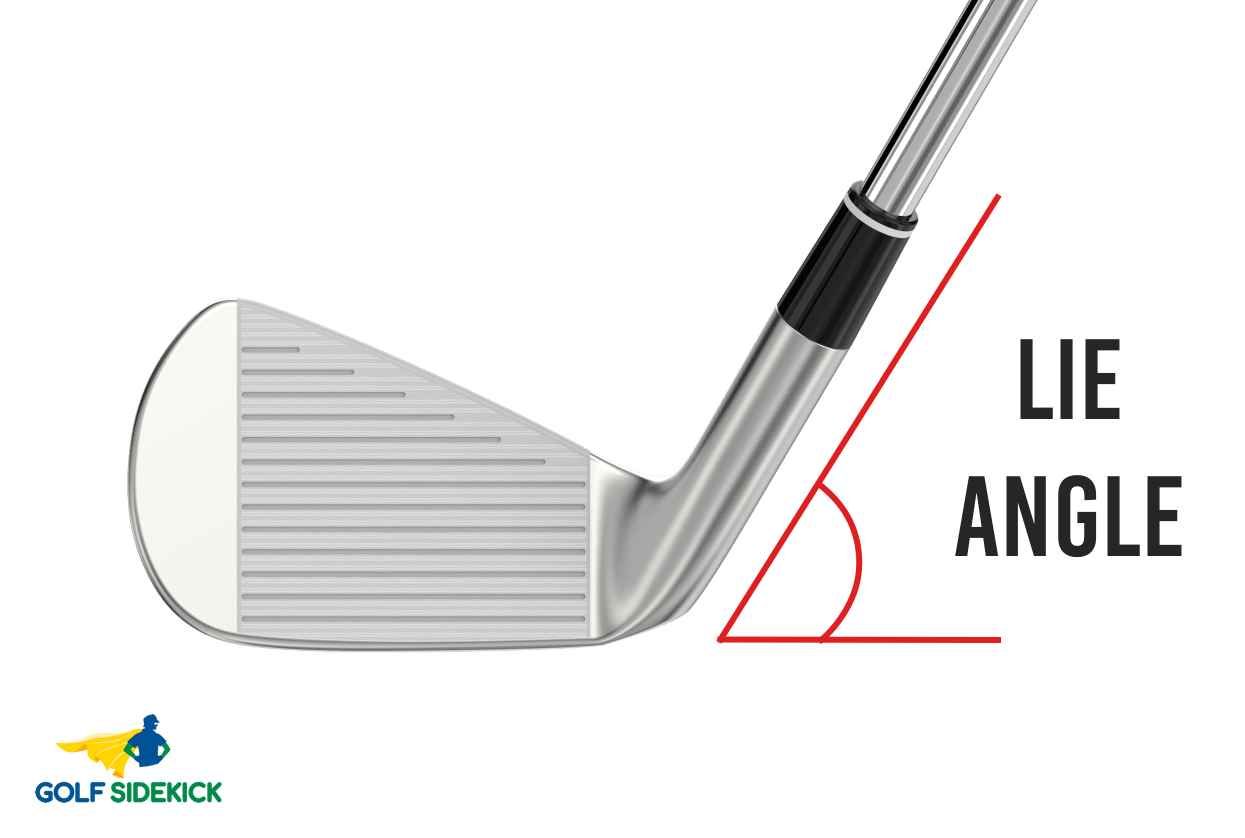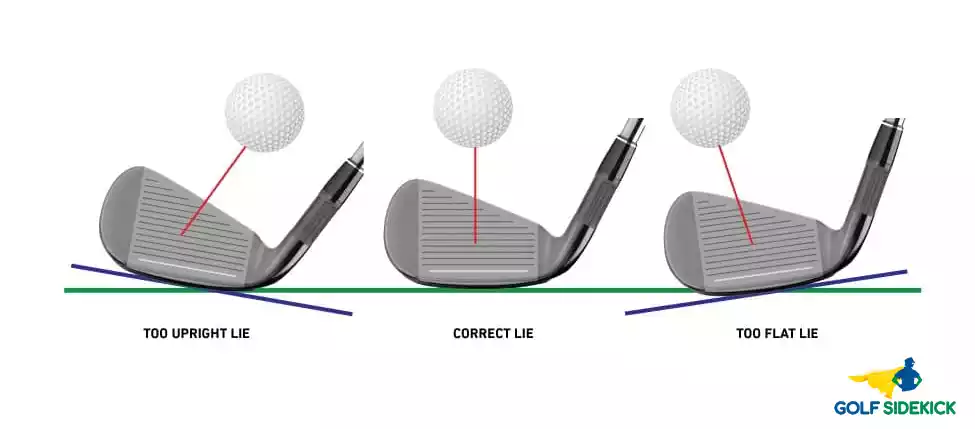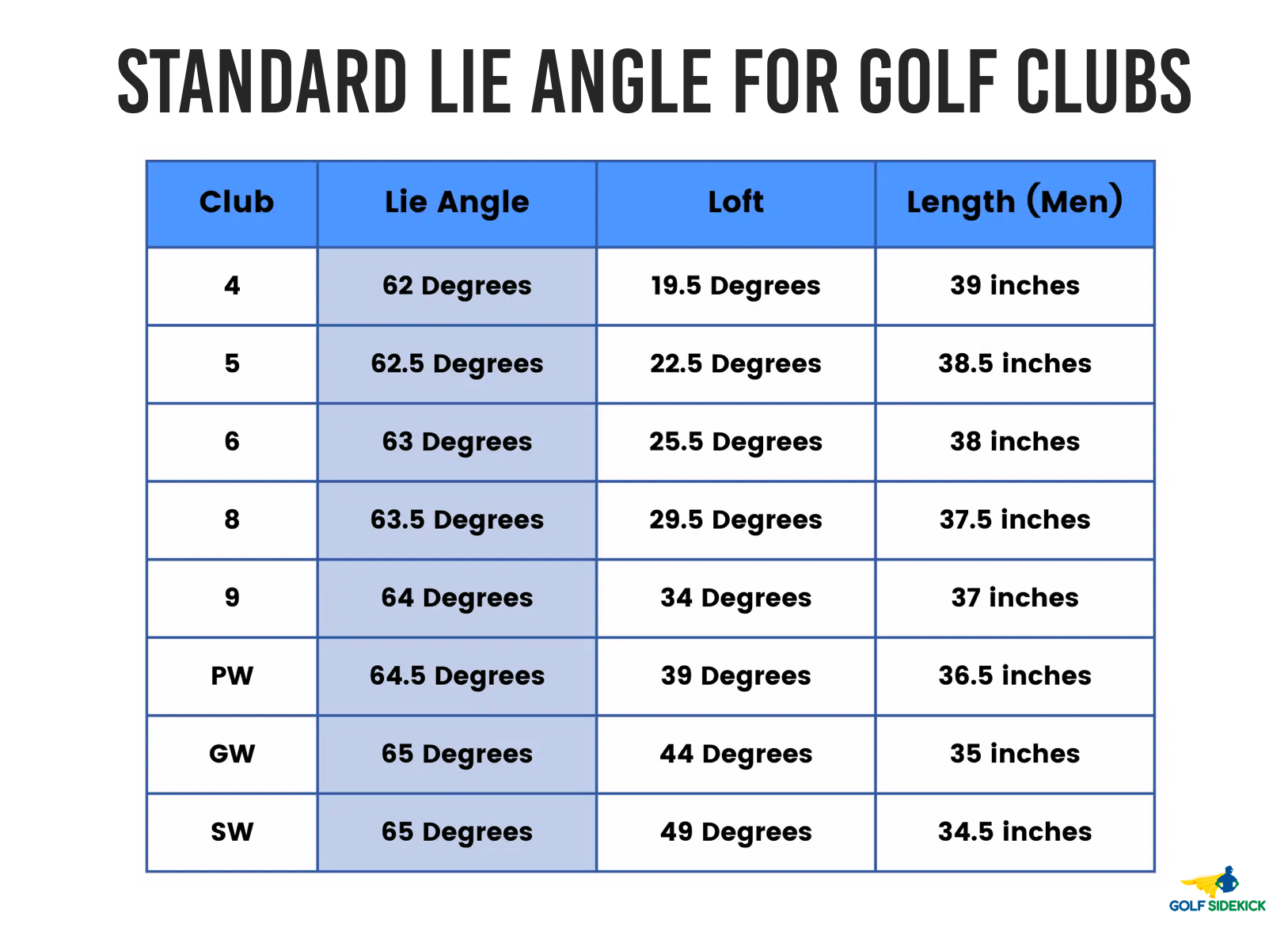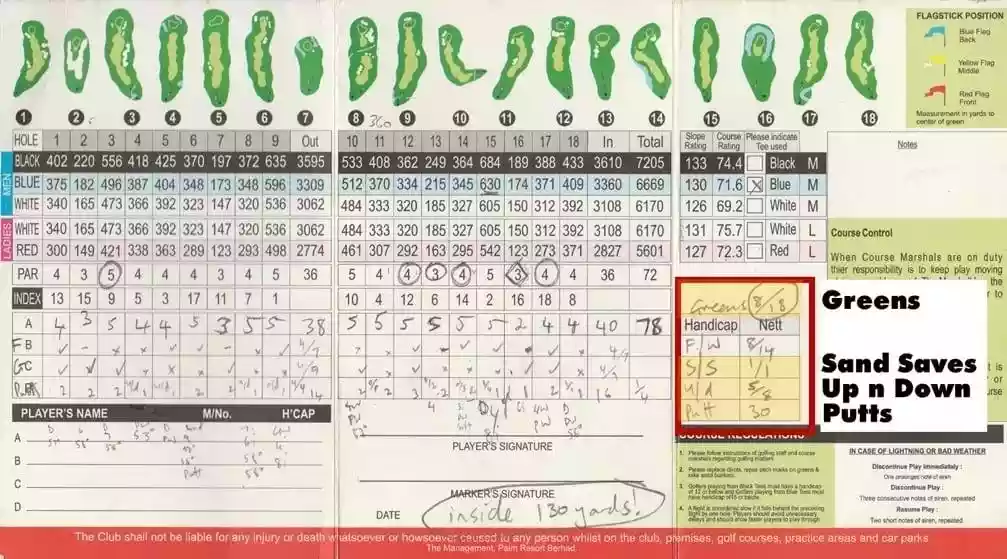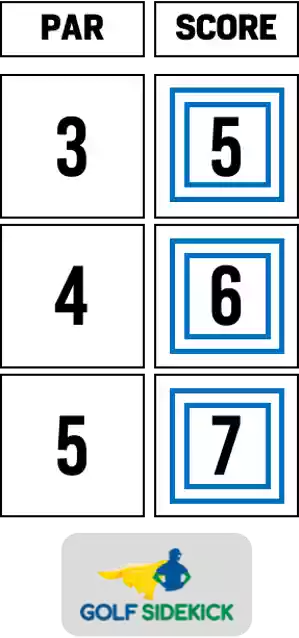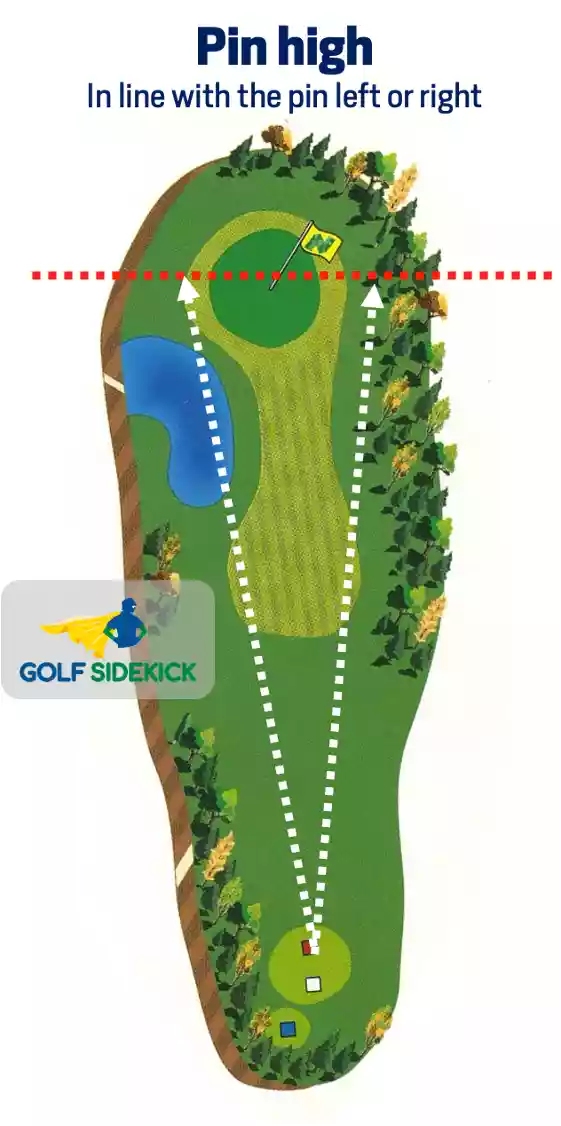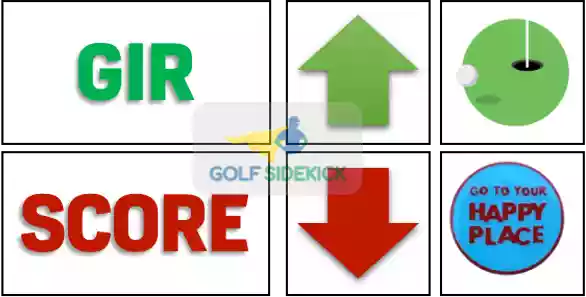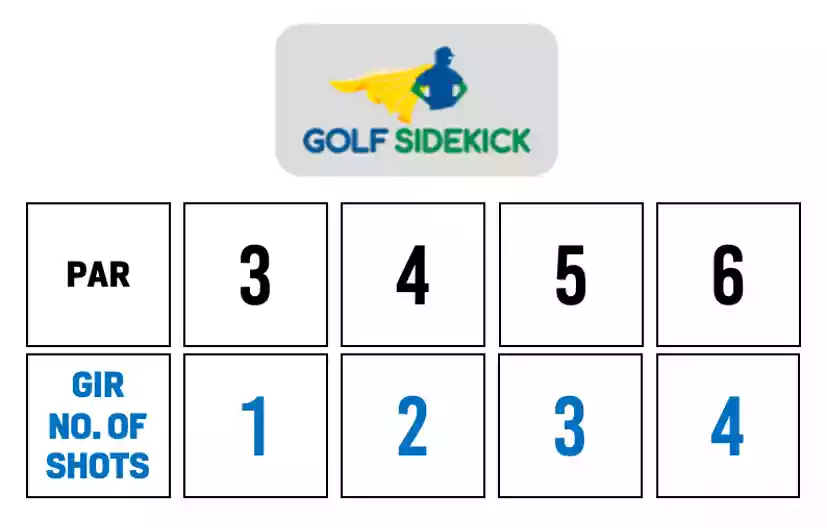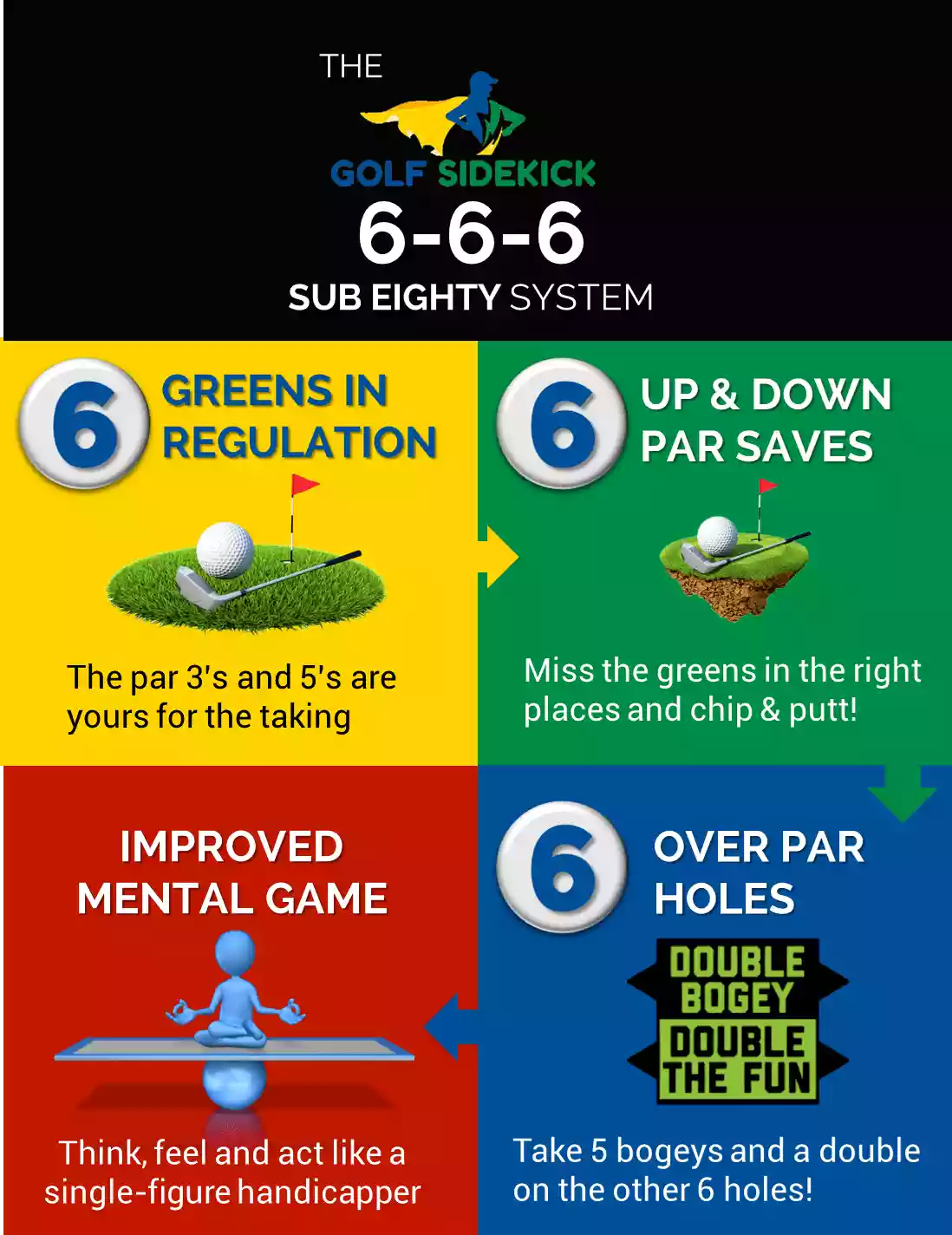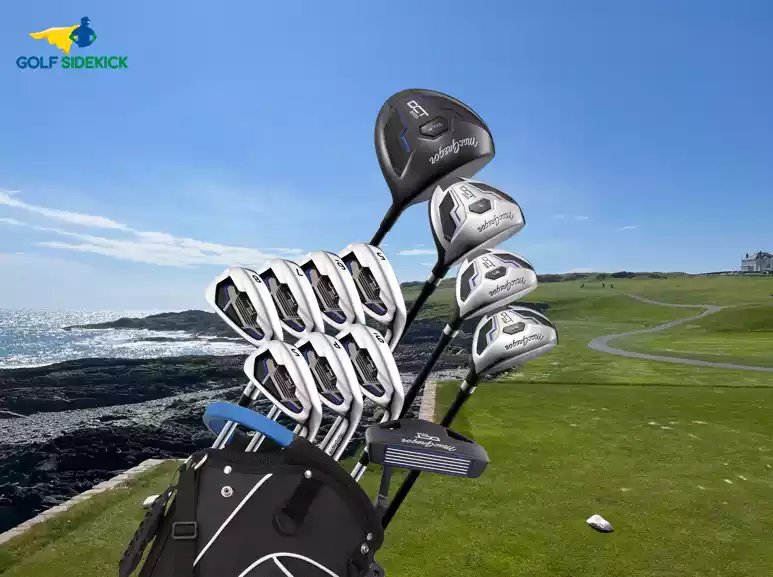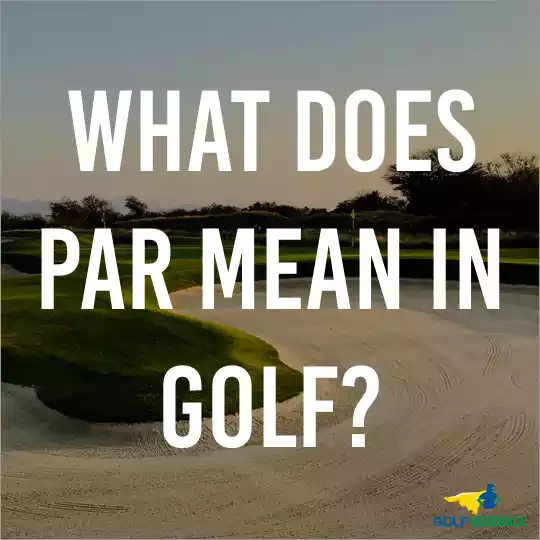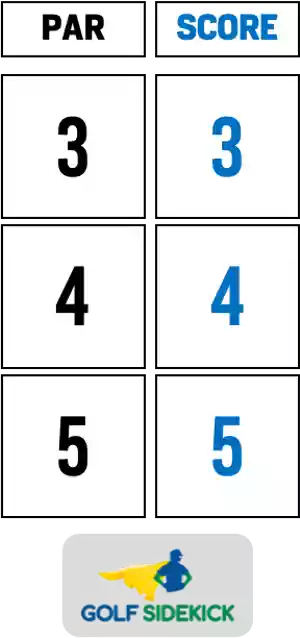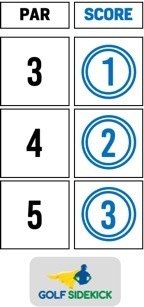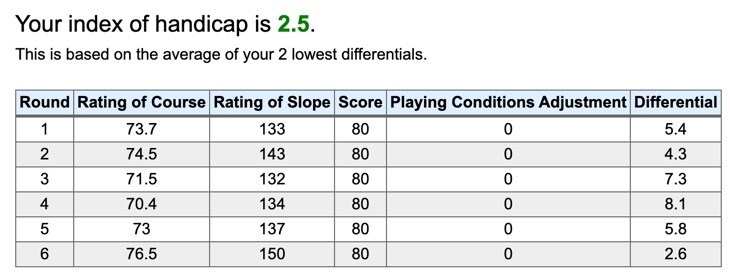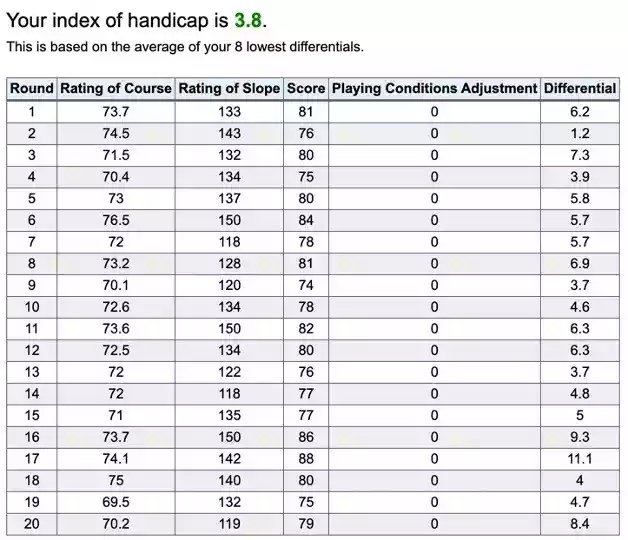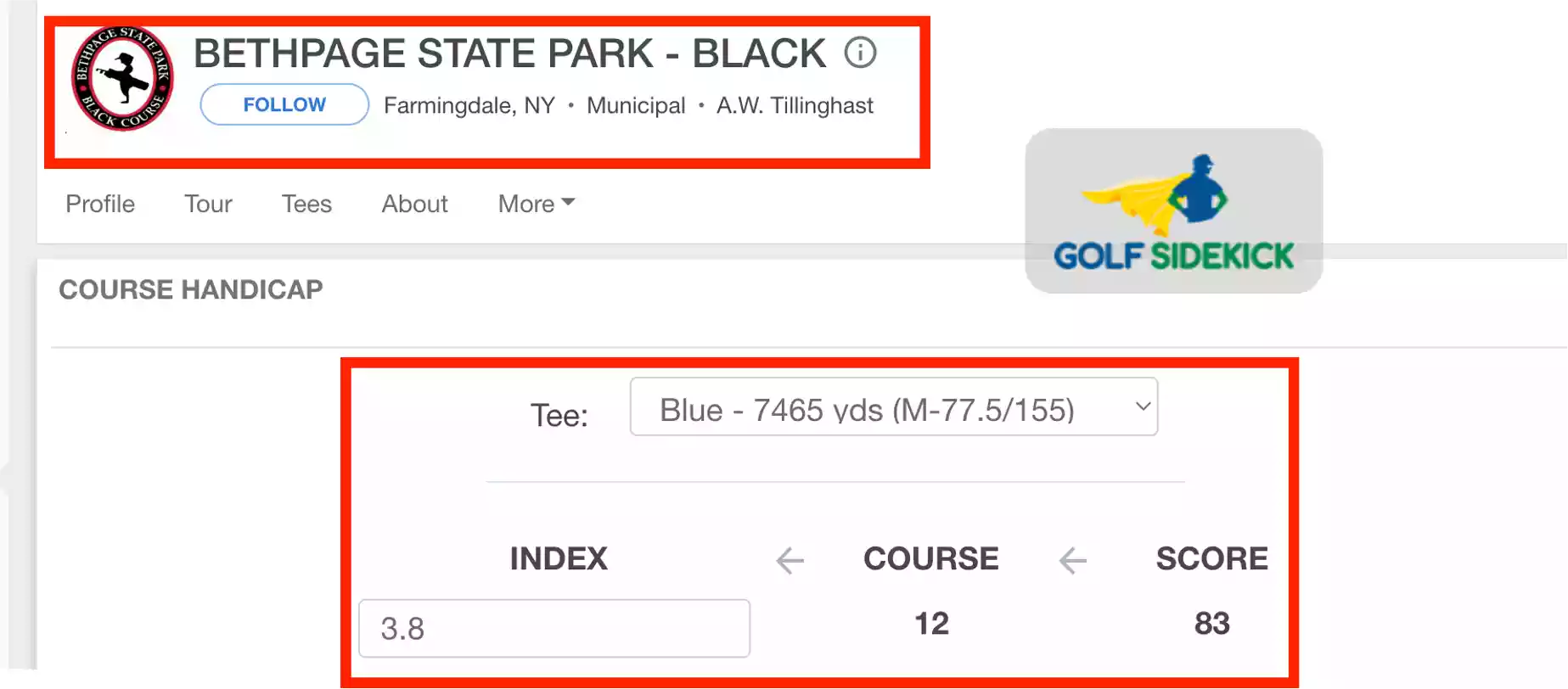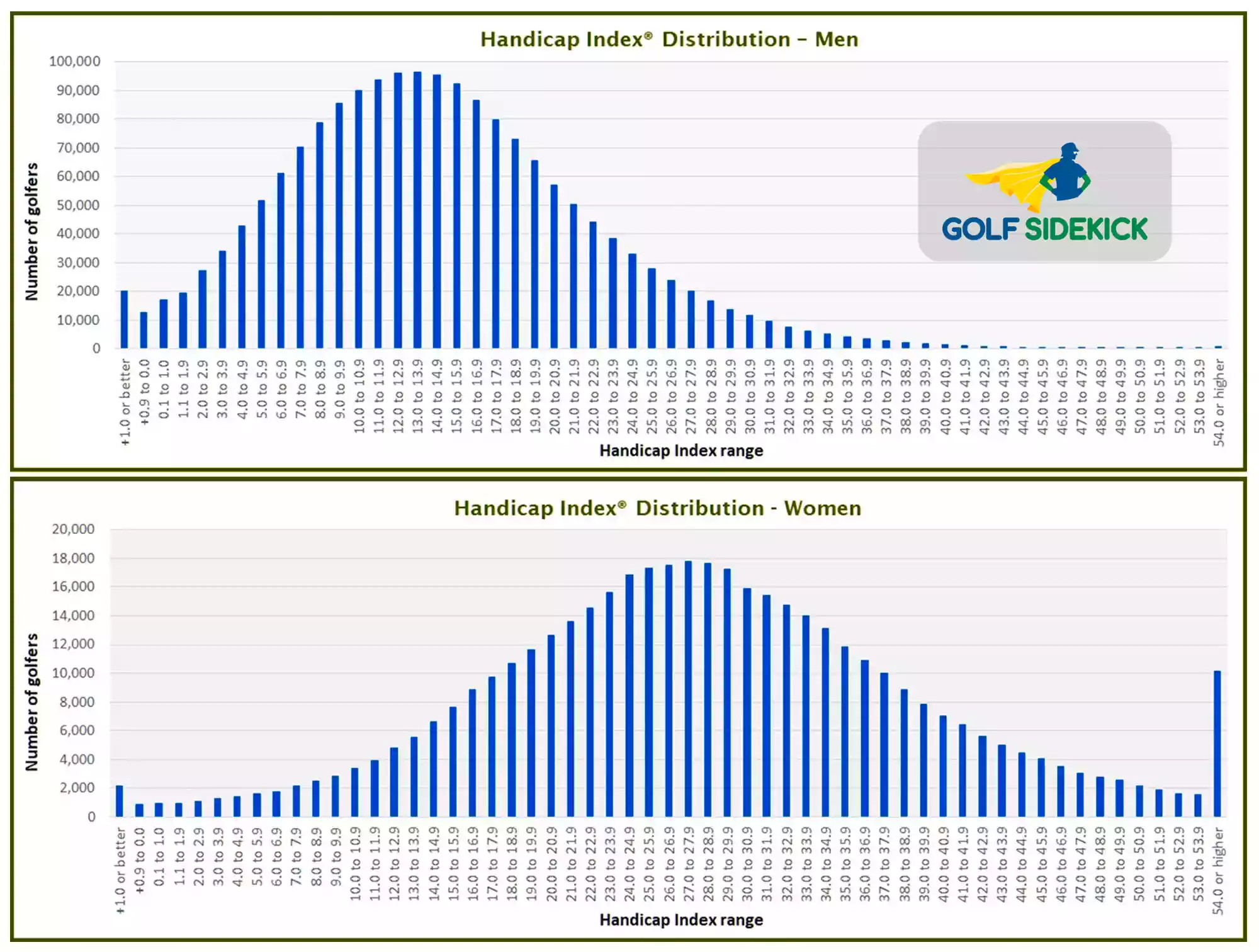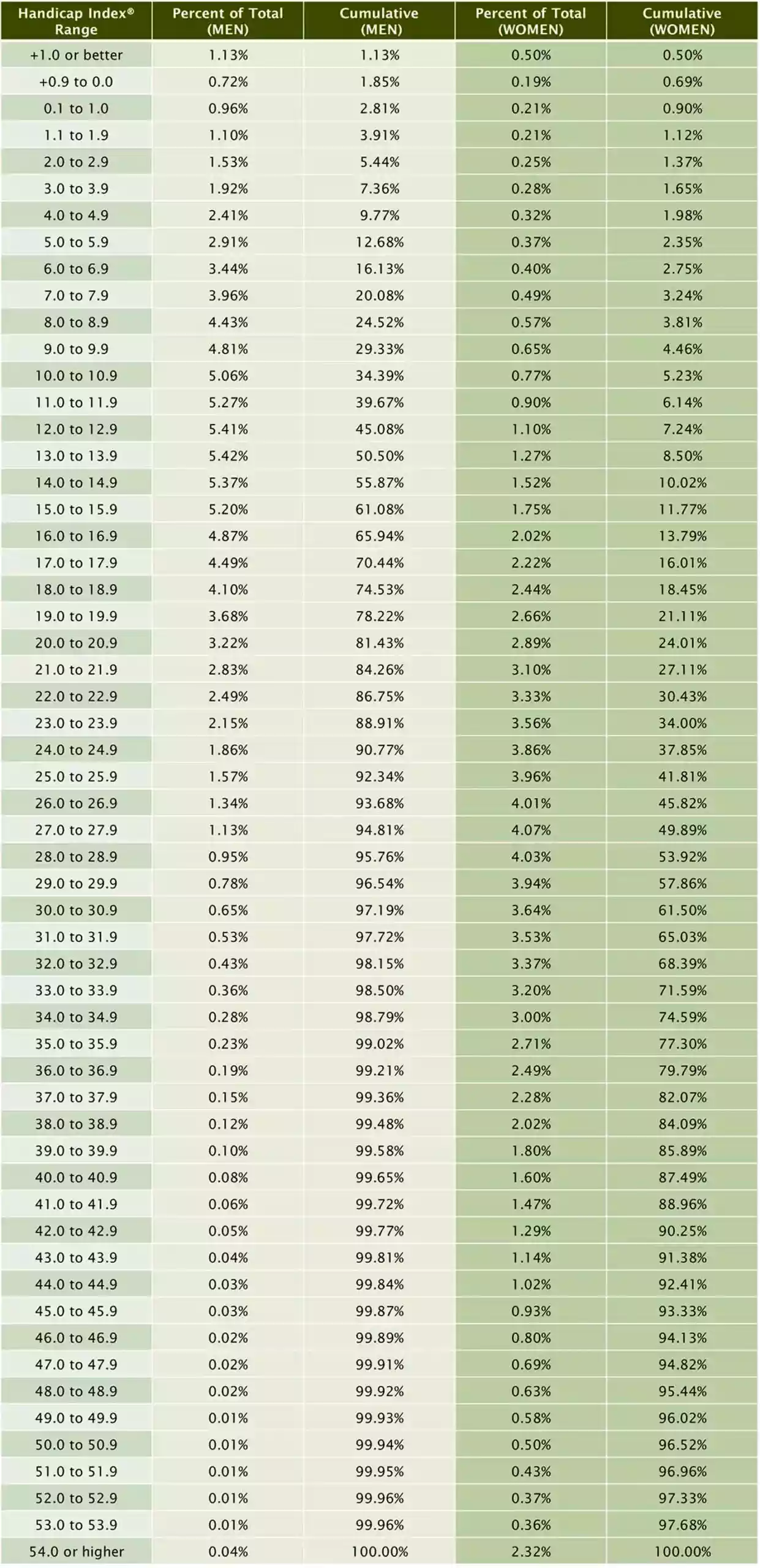Last Updated on January 12, 2024 by Matt Greene
*Read our review guidelines.
Fairway woods and hybrids perform the same purpose in your golf bag - to replace long irons. There are some big differences between them which you may not be aware of.
- Fairway woods and hybrids with the same number printed on the bottom are not the same club.
- Hybrids and fairway woods with the same loft, do not go the same distance for most golfers.
- Hybrids are more versatile than fairway woods around the course.
Let's get more in depth.

Differences between hybrids and fairway woods
If you're new to hybrids and fairway woods, you might think that a 3 hybrid is the same as a 3 wood or a 5 hybrid is the same as a 5 wood. They are different clubs however and they're different in two ways: shaft length and loft.
Fairway woods have longer shafts with bigger club heads than hybrids. They produce more spin and fly much higher in the air than a hybrid of the same loft which means the fairway wood lands softer with less rollout.
Hybrids are a combination of a long iron and a fairway wood. Hybrids have smaller heads and shorter shafts than fairway woods. They produce lower ball flights and lower spin rates than fairway woods which means the ball will roll further after landing. Hybrids usually have more weight in the heel of the club, like an iron does, so most hybrids will create a right to left ball flight.
Hybrids and woods are numbered in a different way
Fairway woods are named after the driver.
The driver is the number 1 wood. After the number 1 wood, follows the 3, 5, 7 and 9 wood. The higher the loft, the higher the number on the bottom of the fairway wood.
Hybrids are designed to replace irons so they are named after the iron they replace. 2 hybrid replaces 2 iron, 3 hybrid replaces a 3 iron etc.
| Loft | Hybrid | Fairway |
| 14-16 degrees | - | 3 wood |
| 17-18 degrees | 2 hybrid | 5 wood |
| 19-20 degrees | 3 hybrid | 5 wood |
| 21-23 degrees | 4 hybrid | 7 wood |
| 24-26 degrees | 5 hybrid | 9 wood |
Hybrids have shorter shafts
Hybrids and fairway woods both come standard with graphite shafts, but the fairway woods always have longer shafts than the hybrid equivalents. Sometimes the shorter shaft can make the club more accurate. The shorter shaft in almost all cases, except for scratch players, will mean a shorter shot than a longer shaft at the same loft.
| Loft | Hybrid | Shaft length | Fairway | Shaft length |
| 14° to 16° | - | 3 wood | 43 inches | |
| 17° to 18° | 2 hybrid | 41 inches | 5 wood | 42.5 inches |
| 19° to 20° | 3 hybrid | 40.5 inches | 5 wood | 42.5 inches |
| 21° to 23° | 4 hybrid | 40 inches | 7 wood | 42 inches |
| 24° to 26° | 5 hybrid | 39.5 inches | 9 wood | 41.5 inches |
Center of Gravity differences
The fairway wood club head is bigger and longer, to move the center of gravity further back from the club face. Moving the center of gravity (CoG) further back helps to elevate the golf ball when you hit the fairway wood off the ground without a tee.
The hybrid club head is much smaller so the center of gravity will be closer toward the club face. You can expect lower launch and less rollout from a hybrid when we compare a hybrid and fairway wood of the same loft.
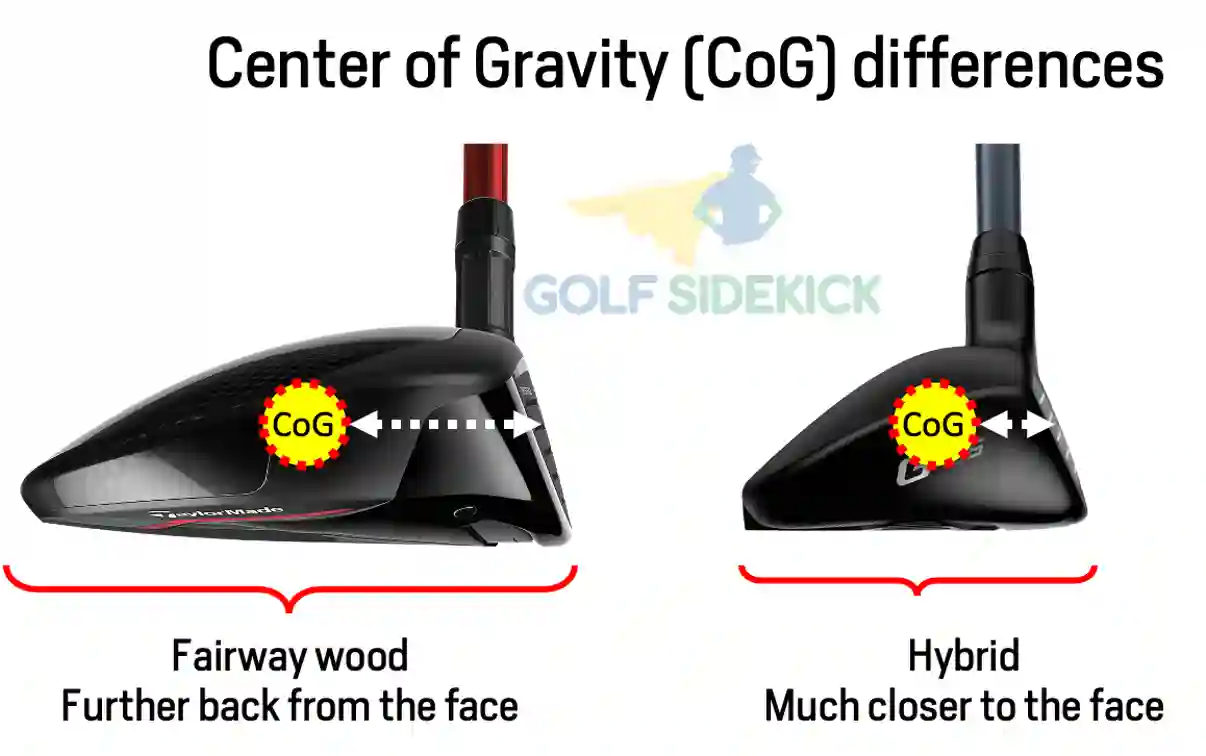
The difference in center of gravity may be the reason that a hybrid is easier to use and more versatile as a chipping club and as a rescue club from tough lies in the rough.
Launch differences of hybrids and fairway woods
The fairway wood launches higher and the ball flies to a higher maximum height than a hybrid of the same loft.
The center of gravity causes the shaft to bend at impact more in a fairway wood, than in a hybrid. That bend helps to launch a fairway wood high when you're hitting it off the fairway. The hybrid launches much lower because the center of gravity is closer to the club face. Center of gravity closer to the club face means there is less shaft bend at impact, which means
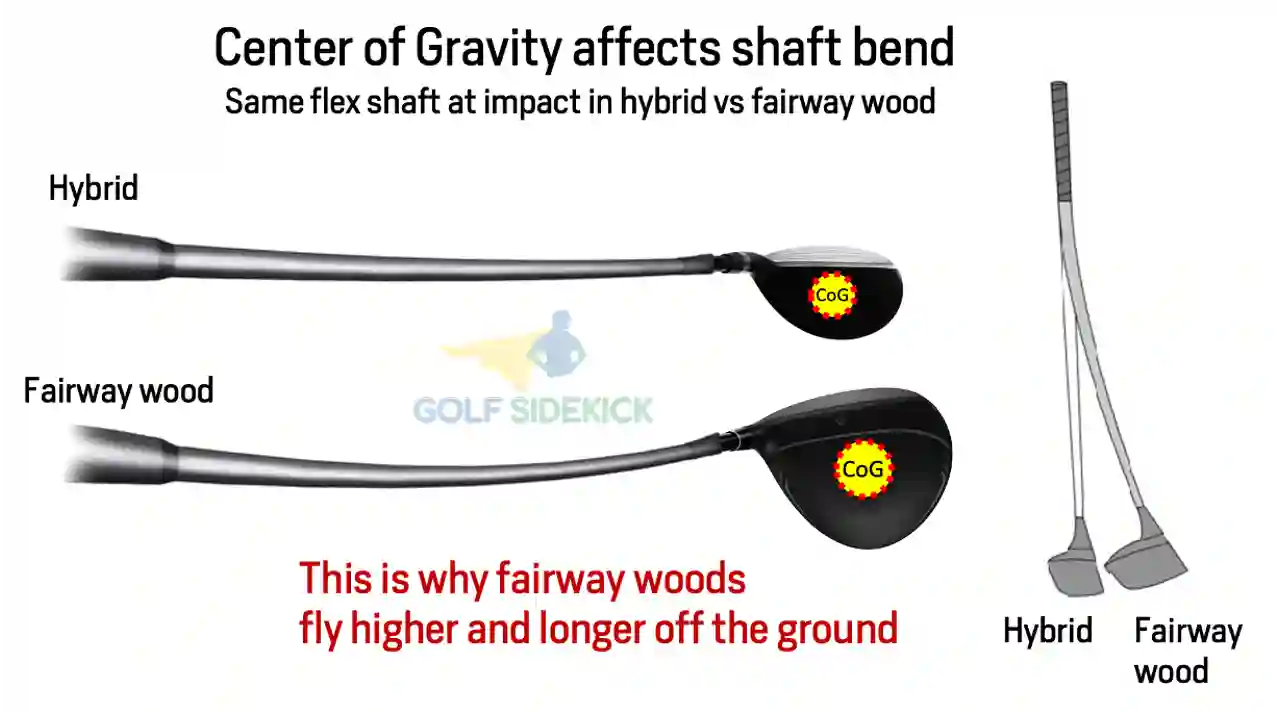
Swing differences
The fairway wood works best with a slightly sweeping swing. Fairway woods have large club heads with big soles that allow a skimming of the club, which launches the ball nice and high.
Hybrids work well with a downward strike like with an iron. Catching the ball on the lower part of the club face is forgiving, but the ball does not fly as far.
How do hybrids and fairway woods with the same loft compare?
From the data we have collected, we conclude that a hybrid will carry a shorter distance than a fairway wood with the same loft.
If we were to use the same length shaft, with the same loft, the carry distance would be identical but the total distance would be longer with a hybrid. The hybrid is a lower spinning, lower launching club which means you will get more rollout than a fairway wood, if we keep shaft length and loft the same.
Fairway wood vs hybrid distance chart
In this table, we compare the carry distance of a 90mph driver swing speed:
| Club | Carry |
| 3 wood (15°) | 195 yards |
| 5 wood (18°) | 185 yards |
| 2 hybrid (18°) | 180 yards |
| 3 hybrid (20°) | 175 yards |
| 7 wood (21°) | 176 yards |
| 4 hybrid (22°) | 169 yards |
| 9 wood (26°) | 165 yards |
| 5 hybrid (25°) | 159 yards |
Fairway woods vs hybrid comparisons
3 wood vs 3 hybrid difference
A 3 wood is a fairway wood with 15 degrees of loft while a 3 hybrid is a long iron replacement with 19-20 degrees of loft.
Not only is the loft different by 5 degrees, but the length of the shaft in a 3 wood is 43 inches while a 3 hybrid is only 41 inches. The 3 woods lower loft and extra length will produce a much longer shot than the 3 hybrid.
An example golfer with 90 mph swing speed will carry a 3 wood around 192 yards but a 3 hybrid around 170 yards.
The actual hybrid equivalent of a 3 wood is a 1 hybrid because both 3 wood and 1 hybrid replace 1 iron in the golf bag.
Which hybrid replaces a 3 wood?
There is no hybrid that replaces a 3 wood. A 3 wood is around 15 degrees of loft and any hybrid of that loft will be too difficult to hit in comparison to a 3 wood.
The old 1 iron was once the 3 wood equivalent but in modern day golf, the 3 wood is the only option in the 15 degree loft range.
5 wood vs 5 hybrid difference
The 5 fairway wood has 17 to 19 degrees of loft but a 5 hybrid is made to replace a 5 iron with 24 or 25 degrees of loft.
The loft difference ranges from 5 to 8 degrees, and the length of the shaft in a 5 wood is 42 inches while a 3 hybrid is 40 inches. A 5 wood will produce a much longer shot due to the longer shaft and lower loft.
A golfer with 90 mph swing speed will carry a 5 wood around 185 yards but a 5 hybrid around 156 yards.
5 wood and 3 hybrid
Differences: The 5-wood and 3-hybrid can be similar in carry distance for fast swing speeds, but with a longer shaft, the 5 wood will generally go further than a 3 hybrid for most average swing speed golfers. At a moderate swing speed, a 5 wood carries 185-190 yards while the 3 hybrid carries about 180-185 yards for male golfers.
Loft
5 wood loft: 16-19 degrees
3 hybrid loft: 19 degrees
Shaft Length
5 wood shaft length: 42 inches
3 hybrid shaft length: 40 inches
Draw bias
3 hybrids are made with offset to help to pull the ball toward the left side, preventing those big left-to-right shots.
5 woods usually have a neutral face but because of the higher loft between 16 and 19 degrees, it is easy to hit with less shot shape than lower lofted clubs.
When to use hybrids vs fairway woods
In my experience, the fairway wood and hybrid are useful in a number of situations but the hybrid is more versatile.
Fairway woods
- More accurate tee shot - 5 wood or 7 wood can ensure a shot in the fairway. 3 wood are not easy to hit and should be avoided.
- Long approach shots or long par 3s
- Higher spin, higher maximum shot height for soft landing with minimal rollout
- Easiest to hit from the fairway or fluffed up lies in the rough
- Lower dispersion due to higher spin rates means you can control the ball better
Hybrids
- More accurate tee shots
- Long approach shots and long par 3s
- Punch shots out of the trees where you need to keep the ball low
- Chipping around the green if you hit bad chips with your wedges
- Lower launch, penetrating ball flight with more rollout due to lower spin
- Easier to hit from tough lies in the rough than irons and fairway woods
- More controllable due to shorter shaft but draw bias can increase dispersion
Conclusion
Mostly the choice to play a hybrid or a fairway wood comes down to preference of ball flight and the type of shot you need.
A fairway wood launches high and lands softly.
A hybrid launches lower and rolls out further.
If you like the look and feel of an iron, the hybrid may be best. If you like the look and feel of fairway woods, they will perform better for you. It all depends on what your goal is. Now you know the differences, you can make the best decisions on the course.

